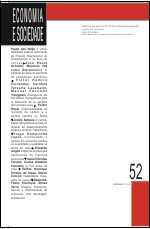Resumo
O trabalho tem como objetivo analisar a relação entre variáveis monetárias e a distribuição espacial das atividades produtivas em um contexto de moeda não neutra. A metodologia consiste na construção e implementação computacional de um modelo de simulação baseado em agentes (agent-based model). Propõe-se um sistema econômico artificial que conecta, por meio do mercado de crédito, os setores produtivo e financeiro, em que o primeiro é caracterizado por concorrência imperfeita (economias de escala e diferenciação assimétrica de produtos) e o segundo, por comportamentos especulativos determinados pela preferência à liquidez. Como resultado, instabilidades geradas endogenamente foram observadas nas simulações, com efeitos sobre a distribuição inter-regional das atividades produtivas. O modelo reproduz importantes regularidades em economia regional, entre as quais uma distribuição rank-size consistente com a Lei de Zipf. Como implicação de política econômica, os resultados sugerem a necessidade da introdução de elementos regionalmente diferenciados na política monetária.
Abstract
This essay aims to analyses the relationship between monetary variables and the spatial distribution of productive activities in a context of non-neutrality of money. The methodology is based on construction and computational implementation of an agent based model which links the productive sector with the financial side of the economy. The productive sector is characterized by imperfect competition (economies of scale and asymmetric product differentiation) and the financial market by speculative behaviors determined by liquidity preference. Among the results, an endogenous instability is observed with impacts on the inter-regional distribution of economic activities. The model reproduces an important stylized fact in regional economics, the Zipf Law, and suggests the need of introducing differentiated regional components in monetary policy.
Keywords: Region. Money. Agents.
Referências
BEARE, J. B. A monetarist model of regional business cycles. Journal of Regional Science, n. 16, p. 57-63, 1976.
CARLINO, G. A.; DEFINA, R. Does monetary policy have differential regional effects? Business Review, p. 17-27, Mar. 1996.
________; ________. The differential regional effects of monetary policy: evidence from the U. S. states. Philadelphia: Federal Reserve Bank, 1997. (Working Paper, n. 97-12).
DIXIT, A.; STIGLITZ, J. E. Monopolistic competition and optimal product diversity. American Economic Review, v. 67, p. 297-308, 1977.
DOW, S. C. (Ed.). Money and the economic process. Aldershot: Edward Elgar Publishing, 1993. 232 p.
EPSTEIN, J. M.; AXTELL, R. Growing artificial societies – social science from bottom-up. Washington: Brookings Institutions Press and the MIT Press, 1996. 209p.
FISHKIND, H. H. The regional impact of monetary policy: an economic simulation study of Indiana 1958-1973. Journal of Regional Science, n. 17, p. 77-88, 1977.
FOLEY, D. K. The strange story of the economic agent. New York: Department of Economics, Graduate Faculty – New School University, 2002. 14 p. Mimeografado.
FUJITA, M.; KRUGMAN, P.; VENABLES, A. The spatial economy. Cambridge: MIT, 1999. 391 p.
GARBAIX, X. Zipf’s law for cities: an explanation. Quarterly Journal of Economics, v. 114, p. 739-767, 1999.
HOLLAND, J. H.; MILLER, J. H. Artificial adaptive agents in economic theory. AEA Papers and Proceedings, p. 365-370, May 1991.
ISARD, W. Location and space-economy: a general theory relating to industrial location market areas, land use, trade, and urban structure. Cambridge: The MIT Press, 1956. 350p.
KALDOR, N. The case for regional policies. Scottish Journal of Political Economy, v. 17, p. 337-48, 1970.
KEYNES, J. M. A teoria geral do emprego, do juro e da moeda: inflação e deflação. São Paulo: Nova Cultural, 1985. 328p.
LIMA, G. T.; FREITAS, G. G. Debt financing and emergent dynamics of a financial fitness landscape. In: ENCONTRO NACIONAL DE ECONOMIA, 35, Recife: Anpec, 2007.
Anais...
MENEZES, M.; CROCCO, M. Avaliação das condições de financiamento do desenvolvimento regional – notas preliminares. In: ENCONTRO NACIONAL DA ANPUR, 11, Salvador, 2005. Anais… MINSKY, H. Stabilizing an unstable economy. New Haven: Yale University Press, 1986. 353p.
MOORE, C. L.; HILL, J. M. Interregional arbitrage and the supply of loanable funds. Journal of Regional Science, v. 22, n. 4, p. 397-404, 1982.
MYRDAL, G. Teoria econômica e regiões subdesenvolvidas. Rio de Janeiro: ISEB, 1960. 210p.
PARUNAK, H.; SAVIT, R.; RIOLO, R. Agent-based modeling vs. equation-based modeling: a case stud and users’ guide. Multi Agent Systems and Agent Based Simulation, v. 1534, p. 1-16, 1998.
PAULA, T. H. P. Financiamento e diversidade produtiva: Um modelo baseado em agentes com flutuações cíclicas emergentes. Revista de Economia Contemporânea, Rio de Janeiro, Instituto de Economia/UFRJ, v. 17, n. 1, p. 5-38, 2013.
RODRIGUEZ-FUENTES, C. J.; DOW, S. C. EMU and the regional impact of monetary policy. Regional Studies, v. 37, n. 9, p. 969-980, 2003.
ROSEN, K. T.; RESNICK, M. The size distribution of cities: an examination of the Pareto law and primacy. Journal of Urban Economics, v. 8, p. 165-186, 1980.
SILVERBERG, G. Evolutionary modeling in economics: recent history and immediate prospects. In: WORKSHOP ON EVOLUTIONARY ECONOMICS AS A SCIENTIFIC RESEARCH PROGRAMME, Stockholm, May, 1997. 16p.
SILVERBERG, G; DOSI, G.; ORSENIGO, L. Innovation, diversity and diffusion: a self-organization model. The Economic Journal, v. 98, p. 1032-1054, 1988.
WILENSKY, U. NetLogo – Center for Connected Learning and Computer-Based Modeling. Evanston: Northwestern University, 1999.
WRAY, L. R. Minsky’s financial instability hypothesis and the endogeneity of money. In: FAZZARI, Steven M.; PAPADIMITRIOU, Dimitri B. Financial conditions and macroeconomic performance: essays in honor of Hyman P. Minsky. Armonk: M. E. Sharpe, 1992. 195p.
O periódico Economia e Sociedade disponibiliza todos os conteúdos em acesso aberto, através da plataforma SciELO, e usa uma licença aberta para preservar a integridade dos direitos autorais dos artigos em ambiente de acesso aberto.
O periódico adotou até Abril/2015 a licença Creative Commons do tipo BY-NC. A partir de Maio/2015 a licença em uso é do tipo Atribuição 4.0 Internacional (CC BY 4.0), disponível no seguinte link: https://creativecommons.org/licenses/by/4.0/deed.pt
Autores são integralmente responsáveis pelo conteúdo e informações apresentadas em seus manuscritos.
O periódico Economia e Sociedade encoraja os Autores a autoarquivar seus manuscritos aceitos, publicando-os em blogs pessoais, repositórios institucionais e mídias sociais acadêmicas, bem como postando-os em suas mídias sociais pessoais, desde que seja incluída a citação completa à versão do website da revista.

